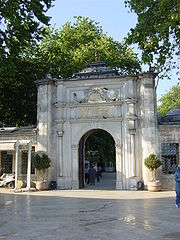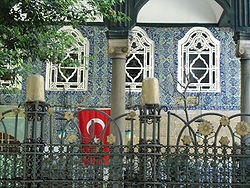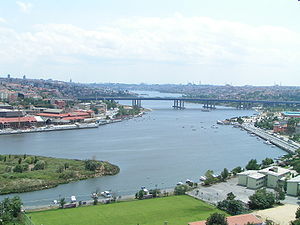
Eyüp
Encyclopedia
Eyüp (ˈeːyp) is a municipality (belediye) and district of the city of Istanbul
, Turkey
. The district extends from the Golden Horn
all the way to the shore of the Black Sea
. Eyüp is also the name of a prominent neighborhood and former village in the district, located at the confluence of the Kağıthane
and Alibey streams at the head of the Golden Horn. The Eyüp neighborhood is a historically important area, especially for Turkey's Muslims
.
, the village pre-dated larger Istanbul since two local streams provided plenty of fresh water. In the Byzantine period
, the village was known under the name of Kosmídion (Κοσμίδιον), and got its name from a church and later a monastery - both dedicated to Saints Cosmas and Damian
- which were built on the steep hill behind today's Eyüp Mosque
.
The monastery was later fortified, and during the First Crusade
it hosted the army of Godfrey of Bouillon
during his sojourn in Constantinople.
The area has long been used as a place of burial, largely due to its position outside the city of Istanbul. There are Christian churches and cemeteries as well as a large Muslim cemetery. The major Muslim shrine gives the area its current name and prominence.

 The name Eyüp comes from Abu Ayyub al-Ansari
The name Eyüp comes from Abu Ayyub al-Ansari
, the companion and standard bearer of the Prophet Muhammad
. Abu Ayyub came to Constantinople with the Arab
army during the first attempted Muslim conquest of the city, died, and as his last request was buried there. Seven centuries later, during the Ottoman conquest of Constantinople, the tomb was said to have been re-discovered by Ak Şemsettin, the spiritual mentor
of Mehmed II
.
After the city was taken, Sultan Mehmet ordered a tomb (türbe
) constructed over Abu Ayyub's resting place and a mosque
, the Eyüp Sultan Mosque
, constructed in his honor. The first major mosque to be built in Istanbul, it was surrounded by a traditional complex including a bath, school, and kitchen.
From that point on, Eyüp became a sacred place. Relics were displayed in the tomb, including a stone said to bear the footprint of the Prophet Muhammad
. More mosques, schools, tekkes
, and fountains were built, and since many Ottoman
officials wished to be buried near Abu Ayyub's resting place, the cemetery became one of Istanbul's most desirable.
At the height of the Ottoman Empire, Eyüp was one of the most recognized urban areas outside the city walls.
came to the city. During this period the Eyüp area was incorporated into the city, losing some of its spiritual air as factories were built along the Golden Horn. The first of these was the Feshane, the factory beside the Golden Horn where fezzes were manufactured for the Ottoman armies. The Feshane is today an exhibition center owned by the Istanbul municipality.
In the meantime, industry, the growing population, and the continuing flow of pilgrims encouraged the growth of the shopping district around and behind the mosque. The streets behind had fish and dairy markets, shops, cafes and bars for residents of the area, while the courtyard of the mosque itself had people selling scriptures and prayer beads to visitors.
From the mid-20th century onward, the area took on a more "working class" feel as wealthier residents of Istanbul preferred to buy housing on the Asia
n side of the city or along the Bosphorus, since the Golden Horn was becoming increasingly polluted and unpleasant due to industrial development. The industrial zone expanded as major roads were built through the Eyüp area. The market gardens and flower fields of Alibeyköy disappeared.
 In recent years many of the factories have been closed or cleaned up, the Golden Horn no longer smells so bad, and it is possible to sit by the waterside. The area has also increasingly attracted conservative Muslim families.
In recent years many of the factories have been closed or cleaned up, the Golden Horn no longer smells so bad, and it is possible to sit by the waterside. The area has also increasingly attracted conservative Muslim families.
The Eyüp Sultan Mosque
continues to draw tourists visiting Istanbul, as well as larger numbers of Turkish religious pilgrims. At Friday prayer
and throughout Ramadan
, the area is full of visitors from all over the city. Pilgrims to the mosque include a wide range of Muslims, especially before weddings or circumcisions.
In recent years, a thriving market has grown around the mosque selling prayer mats, beads, dates from Saudi Arabia, scented oils, Islamic books, recordings of Koran recitation, and other items. On Fridays, a marching band plays Ottoman military music, mehter, giving the area around the mosque a carnival atmosphere with an Islamic twist. In Ramadan, the area in front of the mosque is taken over by large tents where food is served at the evening fast breaking
.
A teleferique brings visitors from the shore of the Golden Horn up to the outdoor Pierre Loti Cafe (Turkish Piyer Loti Kahvesi), a popular spot offering a view of the Golden Horn, named after the 19th-century French
writer Pierre Loti
(pseudonym of Julien Viaud), who wrote two novels based on his stay in Istanbul.
Istanbul
Istanbul , historically known as Byzantium and Constantinople , is the largest city of Turkey. Istanbul metropolitan province had 13.26 million people living in it as of December, 2010, which is 18% of Turkey's population and the 3rd largest metropolitan area in Europe after London and...
, Turkey
Turkey
Turkey , known officially as the Republic of Turkey , is a Eurasian country located in Western Asia and in East Thrace in Southeastern Europe...
. The district extends from the Golden Horn
Golden Horn
The Golden Horn is a historic inlet of the Bosphorus dividing the city of Istanbul and forming the natural harbor that has sheltered Greek, Roman, Byzantine, Ottoman and other ships for thousands of...
all the way to the shore of the Black Sea
Black Sea
The Black Sea is bounded by Europe, Anatolia and the Caucasus and is ultimately connected to the Atlantic Ocean via the Mediterranean and the Aegean seas and various straits. The Bosphorus strait connects it to the Sea of Marmara, and the strait of the Dardanelles connects that sea to the Aegean...
. Eyüp is also the name of a prominent neighborhood and former village in the district, located at the confluence of the Kağıthane
Kagithane
Kağıthane is a working class district of the city of Istanbul, Turkey, in a valley inland from the upmarket Etiler. Built along a stream that runs into the Golden Horn. The mayor is Fazlı Kılıç .-History:...
and Alibey streams at the head of the Golden Horn. The Eyüp neighborhood is a historically important area, especially for Turkey's Muslims
Islam
Islam . The most common are and . : Arabic pronunciation varies regionally. The first vowel ranges from ~~. The second vowel ranges from ~~~...
.
History
Although this area lies outside the city wallsWalls of Constantinople
The Walls of Constantinople are a series of defensive stone walls that have surrounded and protected the city of Constantinople since its founding as the capital of the Eastern Roman Empire by Constantine the Great...
, the village pre-dated larger Istanbul since two local streams provided plenty of fresh water. In the Byzantine period
Byzantine Empire
The Byzantine Empire was the Eastern Roman Empire during the periods of Late Antiquity and the Middle Ages, centred on the capital of Constantinople. Known simply as the Roman Empire or Romania to its inhabitants and neighbours, the Empire was the direct continuation of the Ancient Roman State...
, the village was known under the name of Kosmídion (Κοσμίδιον), and got its name from a church and later a monastery - both dedicated to Saints Cosmas and Damian
Saints Cosmas and Damian
Saints Cosmas and Damian were twin brothers, physicians, and early Christian martyrs born in Cilicia, part of today's Turkey. They practiced their profession in the seaport of Ayas, Adana, then in the Roman province of Syria...
- which were built on the steep hill behind today's Eyüp Mosque
Eyüp Sultan Mosque
The Eyüp Sultan Mosque is situated in the district of Eyüp on the European side of Istanbul, near the Golden Horn, outside the Walls of Constantinople...
.
The monastery was later fortified, and during the First Crusade
First Crusade
The First Crusade was a military expedition by Western Christianity to regain the Holy Lands taken in the Muslim conquest of the Levant, ultimately resulting in the recapture of Jerusalem...
it hosted the army of Godfrey of Bouillon
Godfrey of Bouillon
Godfrey of Bouillon was a medieval Frankish knight who was one of the leaders of the First Crusade from 1096 until his death. He was the Lord of Bouillon, from which he took his byname, from 1076 and the Duke of Lower Lorraine from 1087...
during his sojourn in Constantinople.
The area has long been used as a place of burial, largely due to its position outside the city of Istanbul. There are Christian churches and cemeteries as well as a large Muslim cemetery. The major Muslim shrine gives the area its current name and prominence.
Mosque and türbe of Ayyub al-Ansari


Abu Ayyub al-Ansari
Abu Ayyub al-Ansari - born Khalid ibn Zayd ibn Kulayb in Yathrib - hailed from the tribe of Banu Najjar and was a close companion of Muhammad. Abu Ayyub was one among the Ansar of early Muslim history, or those who supported Muhammad after the hijra to Medina in 622...
, the companion and standard bearer of the Prophet Muhammad
Muhammad
Muhammad |ligature]] at U+FDF4 ;Arabic pronunciation varies regionally; the first vowel ranges from ~~; the second and the last vowel: ~~~. There are dialects which have no stress. In Egypt, it is pronounced not in religious contexts...
. Abu Ayyub came to Constantinople with the Arab
Arab
Arab people, also known as Arabs , are a panethnicity primarily living in the Arab world, which is located in Western Asia and North Africa. They are identified as such on one or more of genealogical, linguistic, or cultural grounds, with tribal affiliations, and intra-tribal relationships playing...
army during the first attempted Muslim conquest of the city, died, and as his last request was buried there. Seven centuries later, during the Ottoman conquest of Constantinople, the tomb was said to have been re-discovered by Ak Şemsettin, the spiritual mentor
Sheikh
Not to be confused with sikhSheikh — also spelled Sheik or Shaikh, or transliterated as Shaykh — is an honorific in the Arabic language that literally means "elder" and carries the meaning "leader and/or governor"...
of Mehmed II
Mehmed II
Mehmed II , was Sultan of the Ottoman Empire for a short time from 1444 to September 1446, and later from...
.
After the city was taken, Sultan Mehmet ordered a tomb (türbe
Turbe
Türbe is the Turkish word for "tomb", and for the characteristic mausoleums, often relatively small, of Ottoman royalty and notables. It is related to the Arabic turba, which can also mean a mausoleum, but more often a funerary complex, or a plot in a cemetery.-Characteristics:A typical türbe...
) constructed over Abu Ayyub's resting place and a mosque
Mosque
A mosque is a place of worship for followers of Islam. The word is likely to have entered the English language through French , from Portuguese , from Spanish , and from Berber , ultimately originating in — . The Arabic word masjid literally means a place of prostration...
, the Eyüp Sultan Mosque
Eyüp Sultan Mosque
The Eyüp Sultan Mosque is situated in the district of Eyüp on the European side of Istanbul, near the Golden Horn, outside the Walls of Constantinople...
, constructed in his honor. The first major mosque to be built in Istanbul, it was surrounded by a traditional complex including a bath, school, and kitchen.
From that point on, Eyüp became a sacred place. Relics were displayed in the tomb, including a stone said to bear the footprint of the Prophet Muhammad
Muhammad
Muhammad |ligature]] at U+FDF4 ;Arabic pronunciation varies regionally; the first vowel ranges from ~~; the second and the last vowel: ~~~. There are dialects which have no stress. In Egypt, it is pronounced not in religious contexts...
. More mosques, schools, tekkes
Khanqah
A Khanqah, Khaniqah , ribat, zawiya, or tekke is a building designed specifically for gatherings of a Sufi brotherhood, or tariqa, and is a place for spiritual retreat and character reformation...
, and fountains were built, and since many Ottoman
Ottoman Empire
The Ottoman EmpireIt was usually referred to as the "Ottoman Empire", the "Turkish Empire", the "Ottoman Caliphate" or more commonly "Turkey" by its contemporaries...
officials wished to be buried near Abu Ayyub's resting place, the cemetery became one of Istanbul's most desirable.
At the height of the Ottoman Empire, Eyüp was one of the most recognized urban areas outside the city walls.
Eyüp during the Industrial Revolution
During the 17th and 18th centuries, Istanbul grew as the fringes of the Ottoman Empire became unsettled and refugees from Turkish communities in the Balkans and the CaucasusCaucasus
The Caucasus, also Caucas or Caucasia , is a geopolitical region at the border of Europe and Asia, and situated between the Black and the Caspian sea...
came to the city. During this period the Eyüp area was incorporated into the city, losing some of its spiritual air as factories were built along the Golden Horn. The first of these was the Feshane, the factory beside the Golden Horn where fezzes were manufactured for the Ottoman armies. The Feshane is today an exhibition center owned by the Istanbul municipality.
In the meantime, industry, the growing population, and the continuing flow of pilgrims encouraged the growth of the shopping district around and behind the mosque. The streets behind had fish and dairy markets, shops, cafes and bars for residents of the area, while the courtyard of the mosque itself had people selling scriptures and prayer beads to visitors.
From the mid-20th century onward, the area took on a more "working class" feel as wealthier residents of Istanbul preferred to buy housing on the Asia
Asia
Asia is the world's largest and most populous continent, located primarily in the eastern and northern hemispheres. It covers 8.7% of the Earth's total surface area and with approximately 3.879 billion people, it hosts 60% of the world's current human population...
n side of the city or along the Bosphorus, since the Golden Horn was becoming increasingly polluted and unpleasant due to industrial development. The industrial zone expanded as major roads were built through the Eyüp area. The market gardens and flower fields of Alibeyköy disappeared.
Eyüp today

The Eyüp Sultan Mosque
Eyüp Sultan Mosque
The Eyüp Sultan Mosque is situated in the district of Eyüp on the European side of Istanbul, near the Golden Horn, outside the Walls of Constantinople...
continues to draw tourists visiting Istanbul, as well as larger numbers of Turkish religious pilgrims. At Friday prayer
Jumu'ah
Jumu'ah is a congregational prayer that Muslims hold every Friday, just after noon in lieu of dhuhr...
and throughout Ramadan
Ramadan
Ramadan is the ninth month of the Islamic calendar, which lasts 29 or 30 days. It is the Islamic month of fasting, in which participating Muslims refrain from eating, drinking, smoking and sex during daylight hours and is intended to teach Muslims about patience, spirituality, humility and...
, the area is full of visitors from all over the city. Pilgrims to the mosque include a wide range of Muslims, especially before weddings or circumcisions.
In recent years, a thriving market has grown around the mosque selling prayer mats, beads, dates from Saudi Arabia, scented oils, Islamic books, recordings of Koran recitation, and other items. On Fridays, a marching band plays Ottoman military music, mehter, giving the area around the mosque a carnival atmosphere with an Islamic twist. In Ramadan, the area in front of the mosque is taken over by large tents where food is served at the evening fast breaking
Iftar
Iftar , refers to the evening meal when Muslims break their fast during the Islamic month of Ramadan. Iftar is one of the religious observances of Ramadan and is often done as a community, with people gathering to break their fast together. Iftar is done right after Maghrib time...
.
A teleferique brings visitors from the shore of the Golden Horn up to the outdoor Pierre Loti Cafe (Turkish Piyer Loti Kahvesi), a popular spot offering a view of the Golden Horn, named after the 19th-century French
French people
The French are a nation that share a common French culture and speak the French language as a mother tongue. Historically, the French population are descended from peoples of Celtic, Latin and Germanic origin, and are today a mixture of several ethnic groups...
writer Pierre Loti
Pierre Loti
Pierre Loti was a French novelist and naval officer.-Biography:Loti's education began in his birthplace, Rochefort, Charente-Maritime. At the age of seventeen he entered the naval school in Brest and studied at Le Borda. He gradually rose in his profession, attaining the rank of captain in 1906...
(pseudonym of Julien Viaud), who wrote two novels based on his stay in Istanbul.

